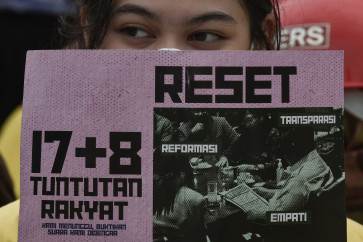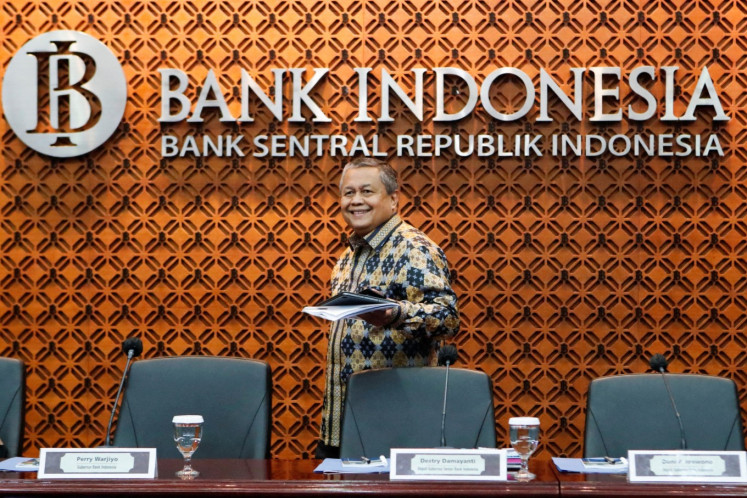Popular Reads
Top Results
Can't find what you're looking for?
View all search resultsPopular Reads
Top Results
Can't find what you're looking for?
View all search resultsAsset securitization for infrastructure financing
Change text size
Gift Premium Articles
to Anyone
A
fter a sluggish growth period, the asset securitization market in Indonesia may see new potential to expand along with the new assets repatriated or declared through the tax amnesty scheme.
A Rp 500 billion (US$37.6 million) transaction made in late August by state-owned Indonesian financier PT Sarana Multigriya Finansial to provide secondary mortgage financing services in cooperation with state-owned PT Bank Mandiri could attract the participation of other banks.
Amid the slowdown in credit and state revenue growth, such deals could help cover the financing deficit, especially in regard with infrastructure development.
There are two structures of asset-backed securities (ABS): the collective investment contract (CIC) and the letter of participation (LP).
The CIC is a basic structure of asset securitization that uses a concept similar to mutual funds in which an investment manager and custodian bank are authorized to manage collective investments.
Other parties involved are the underwriters, rating agencies, credit enhancement, as well as the servicer that collects future payments.
The CIC is more common because it can securitize all financial assets that generate cash flow potential, while the LP is limited to mortgages.
By their structure ABS themselves have many competitive advantages over other instruments both for the originator and the investor.
For the originator, securitization of assets will not affect the financial position (off-balance sheet).
Especially for banks, the implication is capital will not erode, the loan-to-deposit ratio will decrease and more varied sources of financing will be available.
In term of infrastructure financing, the off-balance sheet feature will create higher lending capacity so even a leveraged state-owned enterprise (SOE) like PLN can participate.
Likewise, for investors, ABS can serve as a risk management tools as the instruments have a bankruptcy remoteness feature because the underlying assets would not be subject to confiscation as a result of a declaration of bankruptcy.
Because of these features, the rating of the ABS could be higher than the originator.
However, in addition to the supply and demand, the ABS price may also be influenced by other things, such as the allowance for contingency, insurance and options or swaps toward interest rate or currency exchange rate positions.
Since it was first launched in February 2009, the asset securitization market has only been used to facilitate secondary mortgage financing with only one user, PT Bank Tabungan Negara.
Based on Presidential Decree No. 1/2008 on Amendment of Presidential Decree No. 19 of 2005 on Financing Secondary Housing, securitization is defined as a transformation of illiquid assets to become liquid by way of purchase of financial assets from originator and the issuance of ABS.
Despite the fact that secondary mortgage financing is the origin of the asset securitization market in Indonesia, securitization should be able to serve secondary financing for other sectors as well.
As a result of the single-company show, the ABS market size now is only around Rp 2.5 trillion, which is very low compared to the corporate bond market of Rp 270 trillion and the equity market of Rp 5.7 quadrillion.
Similar to corporate bonds, ABS is only liquid at a maturity of up to 10 years.
The biggest investors in the market are non-financial corporations, followed by financial institutions such as insurance, pension funds, banks and very small contributions from individuals, mutual funds, securities and others.
Based on a survey conducted in August 2016 by the Indonesia Stock Exchange, only about 10 percent of corporations, investment managers and investors have a great understanding of the ABS instruments, while about 90 percent are keen to learn more about these securities.
For corporations, a lack of information disseminated by regulators, the high cost of funds and limited clarity of legal and accounting treatments are indicated to be the impediments for more corporations to use this scheme.
Add the fact that there is nearly no restriction to invest in ABS and some investors are still resistant because of tax treatments, secondary market performances and competing investment policy from stakeholders.
Debottlenecking as well as product development by including sharia-compliant ABS were agreed by survey participants to be essential for the ABS market to take off.
Given the huge needs for infrastructure investment, ABS could potentially fill the gap.
Of the types of assets subject to further regulatory support, the securitization of government-guaranteed debt securities and future receivables could be promoted.
The former example is bonds issued by state-owned Indonesia Infrastructure Finance (PT SMI), whereas the latter example is the future cash flow such as from tolls, electricity bills, flight passenger service charge, and cargo sales charge.
As the bonds have served retail investors well, with better socialization, retail investors should also have room to participate in the ABS market in the future.
This way, Indonesia can reduce its reliance on the state budget for infrastructure financing.
_____________________________
The writer works in the Center of Macroeconomic Policy in the Finance Ministry’s Fiscal Policy Agency. The views expressed are her own.










